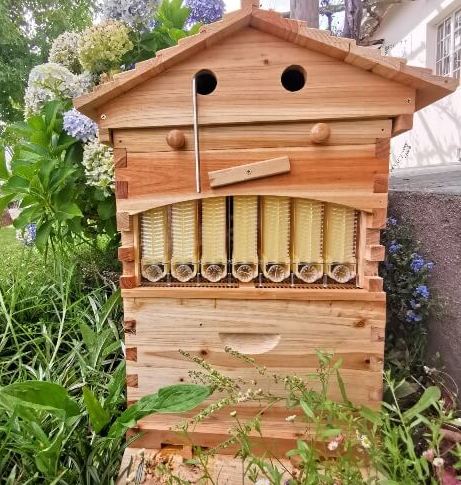Flow Beehive – the Latest Fad or a Genuine Innovation
Bees and humans have had a symbiotic relationship for centuries. We provide them hives and they provide us with delicious golden nectar.
No, we are not referring to large-scale apiaries for commercial production but small farmers who have a few hives.
They get a year-round supply of fresh honey and a lot of wax that can be used for making excellent candles and lip balm. It’s also almost free since only the queen and a few thousand worker bees have to be purchased initially. Thereafter, the hive is self-sustaining.
Consume fresh, organic honey for good health or sell it at a farmer’s market – either way, it’s an excellent activity.
The latest technology is flow hive which makes the honey collection easy. Designed by Stuart Anderson and his son Cedar Anderson, the flow hive is a marvelous design that takes the hard work out of the equation.
Flow beehive – how does it work?
Flow beehive is an invention that makes beekeeping entirely hassle-free.
Well, of course, a beekeeper still has to know how to take care of the brood, but extraction is a lot easier.
A flow hive is a modified Langstroth beehive. The frames are made of plastic and have a honeycomb pattern known as cells. These cells are completed structures and waiting for a bee to fill it with honey and secrete beeswax to cap it.
Underneath there is a spigot and on top, a hole through which the key (a long metal rod) can be inserted.
Turning the key downward puts pressure on the cells. They break off and honey flows out and collects in a channel below that leads to the spigot.
The beekeeper has to place a glass jar underneath the spigot and it fills up in half-hour with pure honey. It’s simple and efficient.
The frame has transparent ends and a beekeeper can see if it is ready for harvesting (all the cells would turn white with beeswax).
If a flow hive has 8 frames, then one is ready for harvesting every week. With 50,000 bees doing heavy lifting, that is a quart of honey every week from one flow hive.
Its appeal lies in the convenience of operation. The traditional method requires a beekeeper to go through a lengthy process that a flow hive completely removes.

How is a flow beehive different from Langstroth?
The most common beehive in use is the conventional Langstroth design which has been around for almost 170 years. The other variety is Warre (not as much in use) which is essentially the same but stacks frames vertically.
These beehives are traditionally made from wood. It’s a natural material and bees prefer it to synthetic objects.
Most commonly used are pine and fir. Some cheaper models are made from water-resistant plywood.
The basic design is that of several boxes stacked on top of each other. Usually, there are two boxes and the upper one is called the super (short for superfluous).
The lower chamber is for the queen.
The whole thing rests on a stand that keeps it clear of the ground.
Inside the boxes are wooden frames. Between 6 and 12 are held in each box. The Langstroth design stacks them side by side.
Modified beehives have them stacked horizontally.
The lower chamber is known as Queens Brood and the upper as Honey Super.
Between them, there is a Queen Excluder that prevents the queen from traveling up the chamber.
There are tiny apertures in the frame that allow bees to enter and leave as they please.
The beekeepers can inspect the hive by taking off the top lid and drawing out the frames. Those that are filled with honey and covered by beeswax are clearly visible.
Why is it difficult to handle a traditional hive?
The trouble arises when you try to take the honey out of the bee colony.
Bees sting at the drop of a hat. The stings are quite nasty and the site swells up becoming red.
Consider that an average beehive has about 30,000 bees and at least several thousand would attack if you tried to take away any honey.
After all, it is their hard work and food for the winter. As far as they understand, you are stealing the fruits of their labor.
There are several steps before an apiarist can extract honey from the hive:
- First cover yourself, head to toe. Hence the need to dress up in overalls that cover skin, wear gloves, and a hat with a veil.
- Next, introduce a little smoke into the hive by burning cotton. This makes the bees less agitated as they can no longer signal to each other that an intruder has arrived.
- Take off the cover. Now pull out the frame that has the heaviest deposit of beeswax and discreetly carry it to an outdoor shed. The bee collector has to ensure that bees don’t follow him because the next stage requires him to take off the gloves and veil.
- Scrape the frame and collect the gunk of wax and honey in a perforated bowl. After about two days, the honey collects in a container below, leaving the wax in the upper bowl.
A lot of very dangerous work. Those who suffer from allergies could die from bee sting. If ten bees sting, most would need immediate medical attention.
Three advantages of a flow beehive?
- No stings attached
It’s scary to extract honey. A dozen bees buzzing and trying to enter the protective suit unnerves most amateurs. The insects are quite persistent and don’t let the frame out of their sight.
In a flow hive, the bees don’t even know that honey is being extracted! The frames are not moved, nor the lid lifted.
There is minimum movement inside too, just enough pressure to break the mouth of cells and tilt them downwards.
Quite a sneaky way to thwart bees.
- No gooey mess
Scraping the gunk made of beeswax takes time and makes a mess. Honey is sticky, and it adheres everywhere – hair, skin, clothes.
A flow hive places honey in a jar. There is no need to let it stand for 2 days to separate the wax from honey.
Since there is no scraping, the wax is not disturbed at all and stays in place.
- See before you taste
The clear frame provides a full view of the interior. The frames are made of top-quality BPA-free plastic that does not give off any odor. They are sturdy enough to withstand summer heat without disintegrating.
From the outside, you can observe how many cells are full and decide if you want to tap that frame. Every frame has its own keyhole and spigot. Cleaning flow hive frames is easy. Just spray it with water and dry it in the sun.

Are there any downsides?
Is flow hive bad for bees? That is a common question a bee expert faces. Unfortunately, yes. A flow beehive does have a few disadvantages.
- Single super box
The flow hive has a big problem – a single super box.
Well, to work, the bees need to eat. If the sole flow hive super box is emptied, how do they get sustenance?
The bees need at least two boxes. One for brood and one for food. Whatever else they create can be taken from a second super box. That is the way beekeeping has been done for two centuries.
- Leaching of plastic
There have been no chemical tests done to find if the plastic does degrade and percolate into honey.
This puts a cloud over the safety and nutritional content. At a time when so many opt for organic foods, this question does not bode well.
Glass does not react with honey and is very safe. Nothing is known about the safety of plastic frames.
- Same sized cells
Expert apiculturists performing a review of flow hive, often have a complaint.
In nature, bees create their own cells. These are of varied size. In a traditional Langstroth box, only a wooden frame is provided. The bees have to construct the cells.
Giving the bees a pre-built cell lowers their inherent capability. These insects have evolved over millions of years. To suddenly break the cycle is an unhealthy way to raise bees. It is as if legs were amputated and wheels fitted so we can travel faster. Hardly a scientific approach.
Choosing convenience is not being slothful
For those who want a hands-off approach, the flow hive is suitable. Flow hive takes away the effort and also the magical appeal of beekeeping.
Most who engage in apiculture do not mind the long process of extraction. Beekeepers have to deal with myriad problems related to weather, poor genetics, foraging by predators, and the flow hive just solves one problem. It gives the notion that beekeeping is now automatic with “honey on tap.”
Convenience however does not always indicate a lack of effort. Purists in every field, have a strong reluctance to depart from the way it has always been done.
Differences will persist between traditionalists and innovators but the flow hive seems a good first step in the right direction.
Read here: